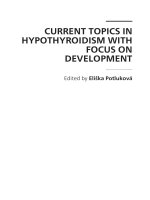(Current topics in membranes and transport 4) felix bronner and arnost kleinzeller (eds ) elsevier, academic press (1974)
Bạn đang xem bản rút gọn của tài liệu. Xem và tải ngay bản đầy đủ của tài liệu tại đây (15.81 MB, 375 trang )
Current Topics
in Membranes
and Transport
Vdllllls 4
Advisory Board
Robert W . Berliner
Britton Chance
I . S. Edelman
Aharon Katchalsky (deceased)
Adam Kepes
Richard D. Keynes
Philip Siekevitz
Torsten Teorell
Daniel C. Tosteson
Hans H . Ussing
Contributors
Richard P. Durbin
Mahendra Kumar Jain
Howard E. Morgan
Carolyn W . Slayman
Carol F . Whitjeld
Current Topics
in Membranes
and Transport
VOLUME 4
Edited by
Felix Bronner
Department of Oral Biology
University of Connecticut Health Center
Farmington, Connecticut
and
Arnost Kleinzeller
Graduate Division of Medicine
University of Pennsylvania
Philadelphia, Pennsylvania
1973
Academic Press
New York and London
A Subsidiary of Harcourt Brace Jovanovich, Publishers
COPYRIGHT 0 1973, BY ACADEMIC
PRESS, INC.
ALL RIGHTS RESERVED.
NO PART OF THIS PUBLICATION MAY BE REPRODUCED OR
TRANSMllTED IN ANY FORM OR BY ANY MEANS, ELECTRONIC
OR MECHANICAL, INCLUDING PHOTOCOPY, RECORDING, OR ANY
INFORMATION STORAGE AND RETRIEVAL SYSTEM, WITHOUT
PERMISSION IN WRITING FROM THE PUBLISHER.
ACADEMIC PRESS, INC.
111 Fifth Avenue, New York, New York 10003
United Kingdom Edition published by
ACADEMIC PRESS, INC. (LONDON) LTD.
24/28 Oval Road, London NWI
LIBRARYOF
CONGRESS CATALOQ
CARD
NUMBER:
PRINTED IN THE UNITED STATES OF AMERICA
70-117091
List of Contributors, vii
Preface, ix
Contents of Previous Volumes, xi
Aharon Katzir-Katchalsky, 1913-1972, xiii
Bibliography of the Principal Publications of Aharon Katzir-Katchalsky on
Membrane Phenomena, xix
The Genetic Control of Membrane Transplant
CAROLYN W. SLAYMAN
I. Introduction, 1
11. Isolation of Transport Mutants, 3
111. Criteria for Identifying Genes That Affect Transport Directly, 136
IV. Linkage Relationships of Transport Mutants, 140
V. Dominance and Recessiveness, 146
VI. Regulation of Transport Systems, 150
VII. Usefulness of Mutants in Understanding Transport Mechanisms, 151
VIII. Conclusion, 155
References, 155
Enzymic Hydrolysis of Various Components in Biomembranes and
Related Systems
MAHENDRA KUMAR JAIN
I. Introduction, 176
11. Action of Hydrolytic Enzymes on Model Systems, 184
111. Effect of Enzymic Hydrolysis on System Properties of Biomembranes, 191
IV. Effect of Enzymic Hydrolysis on Transport Systems, 217
V. Catabolism of Membrane Components by Endogenous Enzymes or
Intracellular Catabolism, 233
VI. Conclusions and Epilog, 236
References, 238
Regulation of Sugar Transport in Eukaryotic Cells
HOWARD E. MORGAN AND CAROL F. WHITFIELD
I. Kinetic Characterization of Passive Transport, 256
11. Nonhormonal Regulation of Sugar Transport, 261
111. Hormonal Control of Sugar Transport, 274
IV. Mechanisms of the Regulation of Transport, 287
V. Summary, 296
References, 297
V
CONTENTS
Vi
Secretory Events in Gastric Mucosa
RICHARD P. DURBIN
I. Introduction, 305
11. Comparative Aspects, 305
111. Structural Aspects, 307
IV. Coupling of Secretion to Metabolism, 313
V. Conclusion, 319
References, 319
Author Index, 323
Subject Index, 340
List of Contributors
Cardiovascular Research Institute and Department of Physiology,
University of California, San Francisco, California
Mahendra Kumar Join, Department of Chemistry, Indiana University, Bloomington,
Indiana*
Howard E. Morgan, Department of Physiology, The Milton S. Hershey Medical Center,
The Pennsylvania State University, Hershey, Pennsylvania
Carolyn w. Slayman, Departments of Human Genetics, Microbiology, and Physiology,
Yale University School of Medicine, New Haven, Connecticut
Carol F. Whitfleld, Department of Physiology, The Milton S. Hershey Medical Center,
The Pennsylvania State University, Hershey, Pennsylvania
Richard P. Durbin,
* Present address: Department of Chemistry, University of Delaware, Newark,
Delaware.
vii
This Page Intentionally Left Blank
The fourth volume of Current Topics in Membranes and Transport extends the analysis of significant transport processes and structures. Carolyn
Slayman presents a comprehensive summary of the genetics of transport,
Jain reviews some aspects of the bilayer nature of the biological membrane,
Morgan and Whitfield deal with sugar transport and its control in eukaryotes, and Durbin reviews some problems of gastric ion secretion. The
editors hope that all interested in biological transport will find these reviews rewarding and provocative.
Last year we dedicated the volume to the memory of Aharon KatairKatchalsky. Caplan’s thoughful appreciation in this volume reminds us of
the breadth of Aharon’s work and of the human qualities that went into it.
We hope this series will continue to reflect the scientific ideal of Aharon
Katdr-Katchalsky, namely a passionate belief in the dispassionate search
for scientific truth.
FELIX BRONNER
ARNOST KLEINZELLER
lx
This Page Intentionally Left Blank
Contents of Previous Volumes
Volume 1
Some Considerations about the Structure of Cellular Membranes
MAYNARD
M. DEWEYAND LLOYDBARR
The Transport of Sugars across Isolated Bacterial Membranes
H. R. KABACK
Galactoside Permease of Escherichia coli
ADAMKEPES
Sulfhydryl Groups in Membrane Structure and Function
ASERROTHSTEIN
Molecular Architecture of the Mitochondrion
DAVIDH. MACLENNAN
Author Index-Subject Index
Volume 2
The Molecular Basis of Simple Diffusion within Biological Membranes
W. R. LIEBAND W. D. STEIN
The Transport of Water in Erythrocytes
ROBERTE. FORSTER
Ion-Translocation in Energy-Conserving Membrane Systems
B. CHANCE
AND M. MONTAL
Structure and Biosynthesis of the Membrane Adenosine Triphosphatase
of Mitochondria
ALEXANDER
TZAGOLOFF
Mitochondria1 Compartments : A Comparison of Two Models
HENRYTEDESCHI
Author Index-Subject Index
xi
xii
CONTENTS OF PREVIOUS VOLUMES
Volume 3
The Na+, K+-ATPase Membrane Transport System: Importance in
Cellular Function
E. LINDENMAYER,
AND
ARNOLD
SCHWARTZ,
GEORGE
JULIUS
C. ALLEN
Biochemical and Clinical Aspects of Sacroplasmic Reticulum Function
ANTHONY
MARTONOSI
The Role of Periaxonal and Perineuronal Spaces in Modifying Ionic Flow
Across Neural Membranes
W. J. ADELMAN,JR.AND Y. PALTI
Properties of the Isolated Nerve Endings
GEORGINA
RODR~GUEZ
DE LORESARNAIZAND
EDUARDO
DE ROBERTIS
Transport and Discharge of Exportable Proteins in Pancreatic Exocrine
Cells : In Vitro Studies
J. D. JAMIESON
The Movement of Water Across Vasopressin-Sensitive Epithelia
RICHARD
M. HAYS
Active Transport of Potassium and Other Alkali Metals by the Isolated
Midgut of the Silkworm
AND KARLZERAHN
WILLIAMR. HARVEY
Author Index-Subject Index
Aharon Katzir-Katchalrky
This Page Intentionally Left Blank
Aharon Katzir-Katchalsky, 1913-1972
To write an objective biographical appraisal of Aharon Katchalsky’s contribution to
the membrane field, with the recollection of his brutal and senseless death a t the hands
of political assassins still raw, is scarcely possible. It is too early, and for one who knew
him as a friend, and fell under his spell as a teacher, too painful. Every aspect of his
work is colored by memories and associations: the elation he could evoke a t a seminar
or discussion around the coffee table; the sense of excitement-sometimes bordering on
euphoria-he never failed to communicate to the audience during his lectures; the intense pleasure he took (and gave) in debating a theoretical point, chalk in hand. He loved
elegance and style wherever he found them, but especially in a page of mathematics;
a blackboard covered with equations in his own graceful handwriting often possessed
something of the richness of a medieval manuscript. Of what manner of a man he washis warmth, humanity, and largeness of spirit-others have written eloquently. For those
of us who had found inspiration in his teaching, including his oldest colleagues, he always
remained in the profoundest sense of the word a mentor.
In a way it is an invidious task to separate Katchalsky’s studies on membranes from
the totality of his work. Viewed as a whole, his work is as impressive in its unity as it is
astonishing in its variety. The twin themes of mechanochemical coupling and chemodiffusional coupling dominate large parts of it, both being intimately related to the most
characteristic properties of biological systems. His contributions to the understanding
of such processes do not, however, stand apart from his contributions to polymer chemistry and nonequilibrium thermodynamics. His ideas on membranes encompassed many
dimensions of the problem and had wide ramifications. The earliest papers, written in
the late ~ O ’ S ,were directed towards the proper understanding of existing experimental
techniques and the proper interpretation of permeability measurements commonly
made on biological membranes. The implications were speedily realized to have importance in the technological application of membranes-especially in desalination. For
Katchalsky, however, synthetic membranes remained models for biological systems, and
by the mid-60’s the problem of the coupling of chemical reaction and transport had
become paramount in his thoughts. In his last years he was deeply concerned with the
mechanism of memory recording, which involved considerations relating to hysteretic
effects in both biopolymers and biomembranes. As always the thermodynamic implications of the phenomena intrigued him, and frequently led him far into the realm of
philosophical speculation.
Katchalsky’s early work on membranes and transport phenomena in general was a
natural outgrowth of his studies, covering more than a decade, of the chemical physics
and biophysics of macromolecules. At the outset of his career he was profoundly impressed by the notion that large polymeric molecules might play an essential role in all
processes occurring in living systems-as a consequence of, among other things, their
conformational degrees of freedom. This was a t a time when little was known of protein
structure and DNA was still to be recognized as the carrier of genetic information.
However, the work of Staudinger and later Kern in the 30’s had suggested that charged
synthetic polymers would be useful as models of biological macromolecules. I n the brief
period between the end of World War I1 and the beginning of the Israeli War of In-
xvi
AHARON KATZIR-KATCHALSKY, 1 9 1 3-1 972
dependence, Katchalsky developed his ideas during a seminal spell in the laboratory of
the redoubtable Werner Kuhn in Basel, and returned to Palestine (as it then was) to
found a school of polyelectrolyte chemistry a t the Hebrew University on Mount SCOPUS.
With the conclusion of hostilities this school shifted to Rehovot, where he was called
upon to establish a polymer department a t the newly-created Weizmann Institute of
Science. Starting with papers in the first volumes of the Journal of Polymer Science in
1946 and 1947,Katchalsky and his colleagues produced a veritable avalanche of theoretical and experimental publications, making an explosive impact on the rapidly growing
field of polyelectrolyte solutions and gels. The impact of these studies was also felt in
the equally rapidly developing technology of ion-exchange resins and membranes,
stimulating the concerns which led ultimately to Katchalsky’s later work on the permeation of salt through charged membranes. In the papers written during this “polyelectrolyte” period the seeds of his deep and lasting interest in mechanochemistry are
to be found, and the profound influence of Gibbsian thermodynamics on his thinking is
already strikingly in evidence.
In the early 50’s Staverman demonstrated the utility of nonequilibrium thermodynamics in describing membrane processes, and introduced the concept of a reflection
coefficient in relation to the osmometry of polymer solutions. Kirkwood showed that local
force equations (written in terms of resistance coefficients), in contrast to local flow
equations, may be integrated across a membrane to give global phenomenological
relations. But very few workers appreciated the power of the method until 1958,
when Kedem and Katchalsky, and also Spiegler, published almost simultaneously and
quite independently their classical papers on the application of nonequilibrium thermodynamics to membrane transport. Kedem and Katchdsky were concerned primarily a t
that time with the permeability of biological membranes to nonelectrolytes; Spiegler waa
concerned with transport processes in ion-exchange membranes. Katchalsky had always
understood the importance of thermodynamics as an organizing principle, often claiming
that it “plays the role of scientific logics.” It was therefore characteristic of his thinking
to invoke nonequilibrium thermodynamics when his attention turned to membranes
and transport.
Undoubtedly the contribution for which Katchalsky is chiefly known (and may well
be chiefly remembered) among workers in the membrane field is precisely his collaborative study of permeability with Kedem, which led to the derivation of what they called
“practical” phenomenological equations. These Kedem-Katchalsky (or K-K) equations
already possess a time-honored air. As Richardson has pointed out, it is little over a
decade since the most complete versions of the equations were publbhed, yet they have
already taken their place alongside the Nernst-Planck and the Goldman equations as
standard working models for physiologists and biophysicists. I n fact the KedemKatchalsky equations are familiar to a generation of young biophysicists who may never
read the original papers. In one simple form, applicable to systems involving a single
solute, the equations describe volume flow (Jy)and solute flow (J.)through a homogeneous membrane in the absence of electric current:
J.
=
c,(l
- u)JV + COAT
(2)
Here A p and AT are the hydrostatic and osmotic pressure differences respectively, and
cs is an average of the solute concentrations in the solutions on either side of the membrane. The “practical” phenomenological coefficients appearing in Eqs. (1) and (2) are
the filtration coefficient L,, the solute permeability U , and the reflection coefficient Q
xvii
AHARON KATZIR-KATCHALSKY, 1913-1 972
originally introduced by Staverman. Prior to the derivation of these equations there
existed no self-consistent treatment of permeability, and certainly none general enough
to cover the whole range of physiological phenomena. Conventional descriptions of
membrane transport made use of two independent flow equations, one for volume and
one for solute, with only two coefficients. Thus volume flow was represented by an
expression of the type
Jv = Lp (Ap - AT)
and solute flow by the Fickian form
both manifestly incomplete in the light of present-day concepts, since the possibility of
coupling between flows is entirely ignored. Although experimentalists had become
progressively aware of the inadequacy of expressions such as these, and although nonequilibrium thermodynamic treatments of transport were in the air and indeed osmotic
pressure measurement had been characterized in terms of the reflection coefficient, it
remained for the Kedem-Katchalsky equations to link the phenomena, for the first time,
into a single gestalt capable of yielding an internally coherent description in physiological
terms. This literally revolutionized membrane studies.
Equation (2) indicates that the solute permeability w is to be determined under condi. an alternative version
tions of zero volume flow, by measuring the ratio ( J s / A ~ ) ~ v 4 In
of the equations a “second permeability” w‘ appears, to be determined under conditions
such that the hydrostatic and osmotic pressure differences just balance, i.e., by measI.
version can be written conveniently in a form
uring the ratio ( J a / A ~ ) ~ 9 - ~This
such that the all-important property of Onsager symmetry (identity of the cross-coefficients) is displayed:
J,
- A T ) + ca(l - U ) L ~ ( A T / C J
- a ) L P ( A p- A T ) + C ~ W ’ ( A T / C J
= Lp(Ap
J a = c,(l
(3)
(4)
Equations (1) and (3) are identical, and the last term in Eq. (4) is obviously just o’Aa.
Clumsy though they are, these expressions bring out the nature of the thermodynamic
forces conjugate to the flows J, and J., which are seen to be ( A p - AT) and ( A r / c . )
respectively. Such conjugate flux-force pairs are generated, according to the methodology
of nonequilibrium thermodynamics, by first deriving the so-called “dissipation function,”
i.e., the temperature times the rate of entropy production due to irreversible processes
in the membrane. This takes the form
T(diS/dt) = J v ( A p
- AT)
J&a0
(5)
where the quantity Apec denotes the concentration-dependent part of the chemical
potential difference of the solute across the membrane. Equation ( 5 ) is exact for dilute
solutions providing that local processes within the membrane obey linear relations.
Kedem and Katchalsky sought to elicit, from the global phenomenological relations
corresponding to this dissipation function, a set of transport coefficients which to some
extent would have the virtue of familiarity to researchers in the field (and thus be readily
accessible experimentally and compatible with existing data), to some extent would be
insensitive to concentration changes, but above all would be thermodynamically selfconsistent. To reconcile these requirements they were compelled to introduce the
xviii
AHARON KATZIR-KATCHALSKY, 191 3-1 972
appropriate average concentration csr such that
Apse = A a j c ,
(6)
Consequently, cs is a logarithmic average. This transformation of the dissipation function
has the virtue of “saving the phenomenon,” and led directly to the formulation of the
practical flow equations.
It is perhaps a reflection of the importance attached to the Kedem-Katchalsky
equations that they did not fail to attract their share of criticism. It has been variously
claimed that they are misleading on a t least two grounds: that their range of validity
(the linear regime) must be vanishingly small, and that global Onsager symmetry cannot
actually hold when bulk flow occurs. This is not the place to analyze such criticisms in
depth, but a comment seems to be called for. It is basic to the nonequilibrium thermodynamic approach that the forces be small enough to ensure linearity of the flux equations. The transformation from ApBcto AT is itself nonlinear since it invokes the logarithmic average concentration-but it is the key to the entire representation. Certainly this
limits the applicability of Eqs. (1) and (2) to very small values of J , or A T , but it does
not by any means render them invalid (especially for the description of physiological
membrane processes). On the contrary, it has been shown repeatedly that the KedemKatchalsky equations represent a first-order expansion of the integrals of the local
frictional equations; indeed the expansion indicates that when the concentration ratio
exceeds (say) 2:1, so that c8 departs by more than a few percent from the arithmetic
average, use of the latter can preserve the linear formalism if J , is not too large. I t also
emerges from such calculations that the reflection coefficients appearing in Eqs. (1) and
( 2 ) [or Eqs. (3) and (4)]are identical, and hence global Onsager symmetry does in fact
obtain, a result which has been verified experimentally in several systems. But clearly
it is in the nature of linear phenomenological equations that they represent behavior
within certain limits-they are not expected to be exact under all circumstances. However small the range of the Kedem-Katchalsky relations may be, their heuristic and
practical importance remains unquestionably immense.
Perhaps the turning point in the realization by biologists of the significance of the
new approach was the memorable symposium on membrane transport and metabolism
held in Prague in 1961, when by all accounts Katchalsky electrified the audience by his
presentation. At any rate, from then on the biological literature reflects a growing interest
in the formalism. Hard on the heels of this meeting appeared an interpretation of the
practical phenomenological coefficients in terms of friction and distribution coefficients.
Here Kedem and Katchalsky turned their attention to charged membranes and demonstrated that for electrolyte permeation through such membranes, the reflection coefficient
u may assume negative values, indicating “anomalous” osmosis. The mechanism of
anomalous osmosis had been a controversial topic: its elucidation in phenomenological
terms was thus a vivid demonstration of the scope of the method. The analysis was performed for a membrane conforming to the well-known Teorell-MeyerSievers fixedcharge model, yielding results in good agreement with the experimental data of Loeb
and of Grim and Sollner. This study led naturally to the consideration of electric current
flow through charged membranes. In an elegant treatment it was shown that if the
potential across the system is applied by means of electrodes reversible to one of the ions
present, the dissipation function requires just one more term-current times the potential
difference between the electrodes.
A fully developed treatment of the permeability of highly charged membranes t o
electrolytes was presented in a series of three successive papers by Kedem and Katchalsky
in 1963. These papers analyzed the properties of composite membranes in terms of series
AHARON KATZIR-KATCHALSKY, 1 9 1 3-1 9 7 2
xix
and parallel arrays, emphasizing the fundamental importance of polarity and circulation
(respectively) in understanding the behavior of such structures. I n particular, this
analysis showed that mosaic membranes may exhibit pronounced negative anomalous
osmosis, i.e., high negative values of u, an effect which had been predicted qualitatively
much earlier by Sollner and demonstrated by Neihof and Sollner. The substance of
Katchalsky’s work on membrane and other transport processes up to this point was
incorporated in the book “Nonequilibrium Thermodynamics in Biophysics” by
Katchalsky and Curran, published in 1965.
I n the late 60’s Katchalsky became increasingly absorbed in the problem of coupling
between diffusion and chemical reaction, especially as manifested in biological membranes. An examination of the thermodynamics and kinetics of active transport in
erythrocytes (with Blumenthal and Ginzburg) was followed by an analysis of facilitated
diffusion (with Blumenthal) which modeled, inter a h , the allosteric transitions of a
carrier protein. At this time periodicity in membranes assumed an important place in
his thinking-especially periodicity related to the presence of chemical reaction. Together with Spangler he showed that if an autocatalytic system undergoes a phase
transition with metastable states, oscillatory behavior can be achieved by appropriately
coupling the reaction t o a membrane transport process regulating the flow of product or
reactant. These considerations invoked the concept of thermodynamically metastable
ateady states and suggested the possibility that hysteresis loops might exist in transitions
between steady states. Such hysteresis cycles in biomembranes were linked t o similar
phenomena in biopolymers and t o the phenomenon of memory.
I n 1969 Katchalsky wrote the following credo*:
I believe that the ultimate goal of biological study is to “translate” the phenomena
of life into meaningful physical concepts. It is rather clear that present-day physics is
still unable t o deal adequately with the complex and diversified expressions of life,
and many years of research and contemplation await the scientists before they will be
able to fit animate and inanimate matter into a common, unified conceptual framework.
The driving force of quantitative biological study is, however, our mystical conviction
that “Nature” is one and that future generations will comprehend life within an integrated
“Natural Philosophy of the Physical World.”
The profound belief in the unity of nature expressed here led Katchalsky t o pondex
deeply the chemical basis of morphogenesis and the origin of life. His ideas were influenced primarily by the early work of Turing on the ability of homogeneous chemical
processes to develop structure spontaneously (as a consequence of a random disturbance) and the more recent work of Prigogine on the thermodynamic theory of structure
and stability. Structures which survive only by the dissipation of an energy input were
termed by Prigogine “dissipative structures.” They can appear in systems maintained
far from thermodynamic equilibrium, and are characterized by an unstable transition
point (a “symmetry-breaking” transition or instability). Such transitions in chemical
systems require nonlinear reaction schemes such as occur in the autocatalytic process
referred to above. Katchalsky considered that dissipative structures may not only play a
major role in the maintenance of certain cellular patterns, but that they may also have
participated in the development of the earliest structures from which life arose.
Prior to his end Katchalsky was preoccupied with several complementary interests:
the nature of prebiotic peptide synthesis, the consequences of chemodiffusional coupling,
* I n “Biology and the Physical Sciences” (S. Devons, ed.). Columbia Univ. Press,
New York.
xx
AHARON KATZIR-KATCHALSKY, 1 9 1 3-1972
and the basis of the molecular memory record. Through all these there runs as a unifying
thread the notion of generation, storage, and retrieval of information. This notion is
strongly reflected in his later writings concerning membrane phenomena. He viewed
chemodiffusional coupling as a structuring agent closely related to biological morphogenesis, and this led him to speculate that active membranes might be dissipative
structures whose dynamics are governed by the very chemodiffusional processes participating in their action. Indeed he conjectured, in agreement with Prigogine, that all
living organization may be based on dissipative structures, fixed to dxerent degrees by
covalent bonds. His deep concern with information flow, energy flow, and the establishment of pattern and shape led him to break fresh ground in the application of thennodynamics to complex systems. A love of thermodynamic rigor expressed itself in
everything he did, and his final major work-which was cut short even as it began to
flourish-was an attempt to develop a “network thermodynamics” especially suited to
the organizational complexity of biological systems. By generalizing network theory to
include irreversible thermodynamic systems, thermodynamics was to be brought within
the framework of modern dynamic systems analysis. The bond graph approach to
systems analysis, still in its infancy, impressed Katchalsky with its versatility as a
representation of arbitrarily complex networks. In his last paper on this subject, completed just before he died, he showed, together with Oster and Perelson, that the bond
graph technique can be used to describe diffusion-reaction systems including facilitated
and active transport, the rectification properties of complex membranes, and relaxation
oscillations in coupled membrane systems.
Many of Katchalsky’s ideas on these and other matters live on in the minds of his
colleagues, and will ultimately see the light of day. But although the direction in which
the broader thrust of his thinking lay may be known, we are denied the pleasure of ever
witneesing its realization. His work will be carried forward, but we shall never know
which path Katchalsky himself would have trodden. The particular flavor and style that
was his will be missing, and so will the insight and the flair for finding connections among
a bewildering variety of seemingly unrelated concepts.
Katchalsky was born in Lodz, Poland, came to Israel in 1925, and received his M.Sc.
and Ph.D. degrees from the Hebrew University in 1937 and 1940. He had many honors,
and engaged in a host of activities. He was the first President of the Israel National
Academy of Sciences and Humanities, President and then Honorary Vice-president of
the International Union for Pure and Applied Biophysics, a Council Member of the
International Council of Scientific Unions, a Foreign Member of the United States
National Academy of Sciences, a Council Member of the European Molecular Biology
Organization, and Visiting Miller Professor of the University of California a t Berkeley.
He was a true Renaissance man, a citizen of the world, renowned for his charismatic
charm, his encyclopedic knowledge of topics ranging from history to philosophy and
metaphysics, his love of the cut and thrust of scientific dialogue. In his work he constantly
emphasized historical perspective, and in his passing he symbolized the historic confrontation of his people-creativity versus hatred and destruction. The cruel snuffing
out of his life deprived us all of a very precious source of enlightenment, but he left a
legacy of riches to build on for a long time.
S. R. CAPLAN
Bibliography of the Principal Publications of
Aharon Katzir-Katchalsky on Membrane Phenomena
Kedem, O., and Katchalsky, A. (1958). Thermodynamic Analysis of the Permeability
of Biological Membranes to Non-electrolytes. Biochim. Biophys. Acta 27, 229.
Katchalsky, A. (1961). Membrane Permeability and the Thermodynamics of Irreversible
Processes. “Membrane Transport and Metabolism” (A. Kleinzeller and A.
Kotyk, eds.), p. 69. Academic Press, New York.
Kedem, O., and Katchalsky, A. (1961). A Physical Interpretation of the Phenomenological Coefficients of Membrane Permeability. J . Gen. Physiol. 45, 143.
Katchalsky, A,, and Kedem, 0. (1962). Thermodynamics of Flow Processes in Biological
Systems. Biophys. J . 2, 53.
Kedem, O., and Katchalsky, A. (1963). Permeability of Composite Membranes. Part I.
Electric Current, Volume Flow and Flow of Solute Through Membranes. Trans.
Faraday SOC.59, 1918.
Kedem, O., and Katchalsky, A. (1963). Permeability of Composite Membranes. Part 11.
Parallel Elements. Trans. Faraday SOC.59, 1931.
Kedem, O., and Katchalsky, A. (1963). Permeability of Composite Membranes. Part 111.
Series Array of Elements. Trans. Faraday SOC.59, 1941.
Ginaburg, B. Z., and Katchalsky, A. (1963). The Frictional Coefficients of the Flows of
Nonelectrolytes through Artificial Membranes. J . Gen. Physiol. 47, 403.
Katchalsky, A., and Curran, P. F. (1966). “Nonequilibrium Thermodynamics in Biophysics,” Harvard Univ. Press, Cambridge, Massachusetts.
Blwnenthal, R., Ginzburg, B. Z., and Katchalsky, A. (1967). Thermodynamic and
Model Treatment of Active Ion Transport in Erythrocytes. “Hemorheology”
(Proc. First Intern. Conf.), p. 91, Pergamon, New York.
Katchalsky, A. ( 1967). Membrane Thermodynamics. “The Neurosciences, A Study
Program” (G. C. Quarton, T. Melnechuk, and F. 0. Schmitt, eds.), p. 326. The
Rockefeller Univ. Press, New York.
Katchalsky, A., and Spangler, R. (1968). Dynamics of Membrane Processes. Quart. Rev.
Biophys. 1, 127.
Katchalsky, A. ( 1968). Thermodynamic Treatment of Membrane Transport. Pure Appl.
Chem. 16,229.
Katchalsky, A. (1968). Thermodynamic Consideration of Biological Membranes. “Membrane Models and the Formation of Biological Membranes” (L. Bolis and B. A.
Pethica, eds.), p. 318. North-Holland, Amsterdam.
Blumenthal, R., and Katchalsky, A. (1969). The Effect of the Carrier AssociationDissociation Rate on Membrane Permeation. Biochim. Biophys. Acta 173, 367.
Katchalsky, A. (1969). Membrane Thermodynamics. “Membranes $. Permeabilite
SBlective,” p. 19. Editions du Centre National de la Recherche Scientifique, Paris.
Katchalsky, A. ( 1969). Non-equilibrium Thermodynamics of Bio-Membrane Processes.
“Theoretical Physics and Biology” (M. Marois, ed.), p. 188. North-Holland,
Amsterdam.
Katchalsky, A., and Oster, G. (1969). Chemico-Diffusional Coupling in Biomembranes.
xxi
xxii
AHARON KATZIR-KATCHALSKY, 1 9 1 3-1 972
“The Molecular Basis of Membrane Function” (D. C. Tosteson, ed.), p. 1. PrenticeHall, Englewood Cliffs.
Katchalsky, A. (1970). Thermodynamic Consideration of Active Transport. “Permeability and Function of Biological Membranes” (L. Bolis, A. Katchalsky, R. 1).
Keynes, W. R. Loewenstein, and B. A. Pethica, eds.), p. 20. North-Holland,
Amsterdam.
Katchalsky, A. (1971). Thermodynamics of Flow and Biological Organization. ZYGON:
J . Relig. Sci. 6, 99.
Katchalsky, A. (1971). Biological Flow Structures and Their Relation to ChemicoDiffusional Coupling. Neurosci. Res. Prog. Bull. 9, 397.
Oster, G., Perelson, A., and Katchalsky, A. (1971). Network Thermodynamics. Nature
(London) 234, 393.
Katchalsky, A., and Neumann, E. (1972). Hysteresis and Molecular Memory Record.
Int. J . Neurosci. 3, 175.
Oster, G. F., Perelson, A. S., and Katchalsky, A. (1973). Thermodynamics of Biological
Networks. Quart. Rev. Biophys. 6, 1.
The Genetic Control of Membrane Transport
CAROLYN W. SLAYMAN
Departments of Human Genetics. Microbiology. and Physiology.
Yale Univwsily School of Medicine. New Haven. Connecticut
.
.
Introduction . . . . . . . . . . . . . . . . . .
Isolation of Transport Mutants
. . . . . . . . . . . .
A Resistance t o Analogs . . . . . . . . . . . . . .
B Selection of Nongrowing Cells
. . . . . . . . . . .
C Direct Screening for Uptake . . . . . . . . . . . .
D . Recognition of Transport Defects in Higher Organisms . . . .
E . The Strategy of Recovering Transport Mutants . . . . . .
F. The Problem of Multiple Transport Systems for a Single Substrate .
I11. Criteria for Identifying Genes that Affect Transport Directly . . . .
IV Linkage Relationships of Transport Mutants
. . . . . . . .
A . Escherichia coliand Salmonella typhimurium . . . . . . .
B . Neurospora crassa . . . . . . . . . . . . . . .
V Dominance and Recessiveness . . . . . . . . . . . . .
VI . Regulation of Transport Systems . . . . . . . . . . . .
VII . Usefulness of Mutants in Understanding Transport Mechanisms . . .
A . In Determining the Number of Separate Transport Systems for a
Particular Substrate
. . . . . . . . . . . . . .
B In Identifying the Components of a Transport System . . . .
C . In Determining the Functionof a Component . . . . . . .
VIII . Conclusion
. . . . . . . . . . . . . . . . . .
References
. . . . . . . . . . . . . . . . . .
I
I1
.
.
.
.
.
.
1
3
3
129
132
133
133
134
136
140
140
144
146
150
151
151
152
152
155
155
1. INTRODUCTION
The genetic approach to the study of membrane transport can be an
extremely useful one. By isolating and mapping mutants defective in the
transport of a particular substrate. it is possible to determine the number
of systems involved and even the number of subunits in each system;
by analyzing the kinetics and the biochemistry of transport in the mutants.
1
2
CAROLYN W. SLAYMAN
one can often obt,ain information about molecular mechanisms. Progress
in both of these areas is discussed in this article, together with some of
the problems that remain.
Membrane genetics is still a relatively young field. The first realization
that transport systems, like simple cytoplasmic enzymes, are under
genetic control came in the 1950s with work on cystinuria in man and
lactose transport in Escherichia coli. Cystinuria had long been known to
be an inherited disease, and in fact was one of the “inborn errors of
metabolism” (together with pentosuria, alkaptonuria, and albinism)
discussed by Archibald Garrod in his famous Croonian lectures in 1908.
By 1951 cystinuria had been shown to involve the excretion of abnormal
amounts of arginine, lysine, and ornithinc, as well as cystine. The structural
relationship among this group of amino acids led Dent and Rose (1951)
to postulate that the disease was caused by a primary defect in transport
across the renal tubules. Since that time cystinuria has been found to
affect the intestinal mucosa as well, and the transport defect has been
well characterized i n vitro in intestinal tissue obtained by biopsy (Thier
et al., 1964, 1965; McCarthy et al., 1964). In addition, other inherited
diseases have been shown to lead to transport defects in man (for example,
Hartnup disease, iminoglycinuria, methionine malabsorption, tryptophan
malabsorption, X-linked hypophosphatemia), and the idea that all
mammalian transport systems are under genetic control-even though
mutations may often be lethal or otherwise undetectable-is now widely
accepted.
The genetic analysis of transport in microorganisms also dates to the
1950s. Although the earlier results of Davis and of Doudoroff had drawn
attention to the cryptic nature of certain enzyme systems in bacteria
(in which intact cells were unable to metabolize a given substrate even
though cell-free extracts contained the necessary enzymes), it was the
work of Cohen and Rickenberg (1955) and Rickenberg et al. (1956) that
first demonstrated the existence of a specific bacterial transport system.
These investigators showed that the product of the lacy gene is required
for the transport of p-galactosides in E . coli, and that its synthesis is
regulated jointly with the synthesis of the enzyme 8-galactosidase. The
kinetics of the transport system have since been examined in detail,
both in wild-type E. coli and in lacy mutants, and more recently the
l a c y gene product ([%I
protein”) has been isolated by Fox and Kennedy
(1965). In microorganisms, and particularly in E . coli, this initial work has
been followed by the isolation of many different kinds of transport mutants,
and the notion that transport systems are genetically determined has been
amply documented.
This article discusses tfhetechniques that have been developed to isolate









